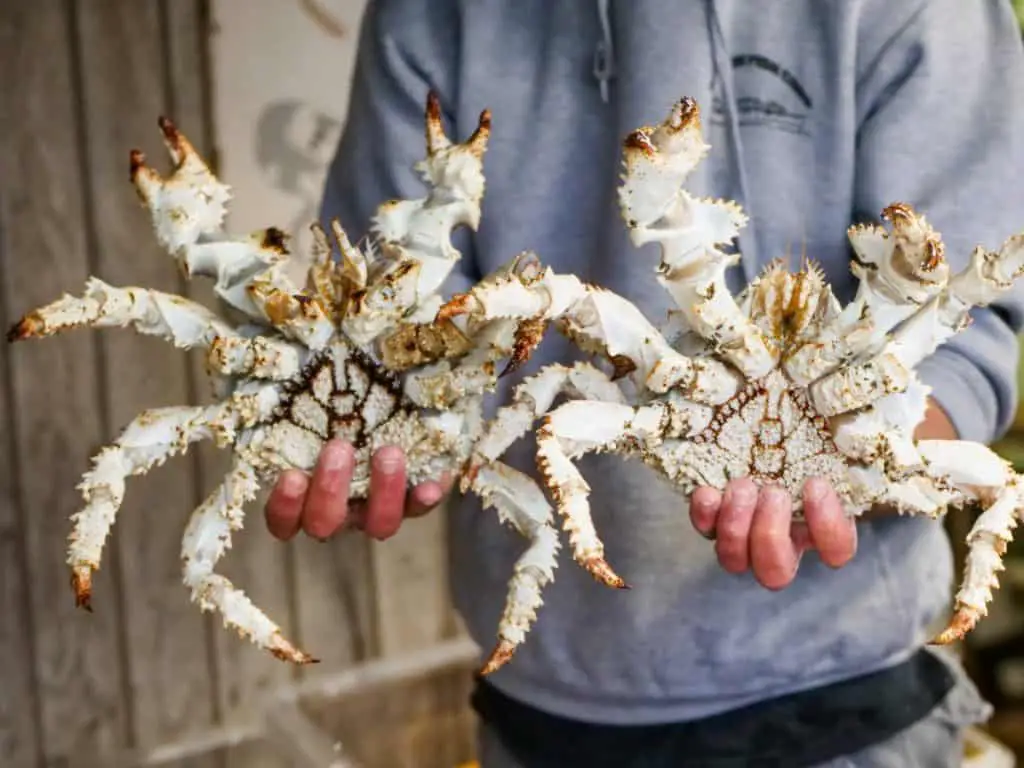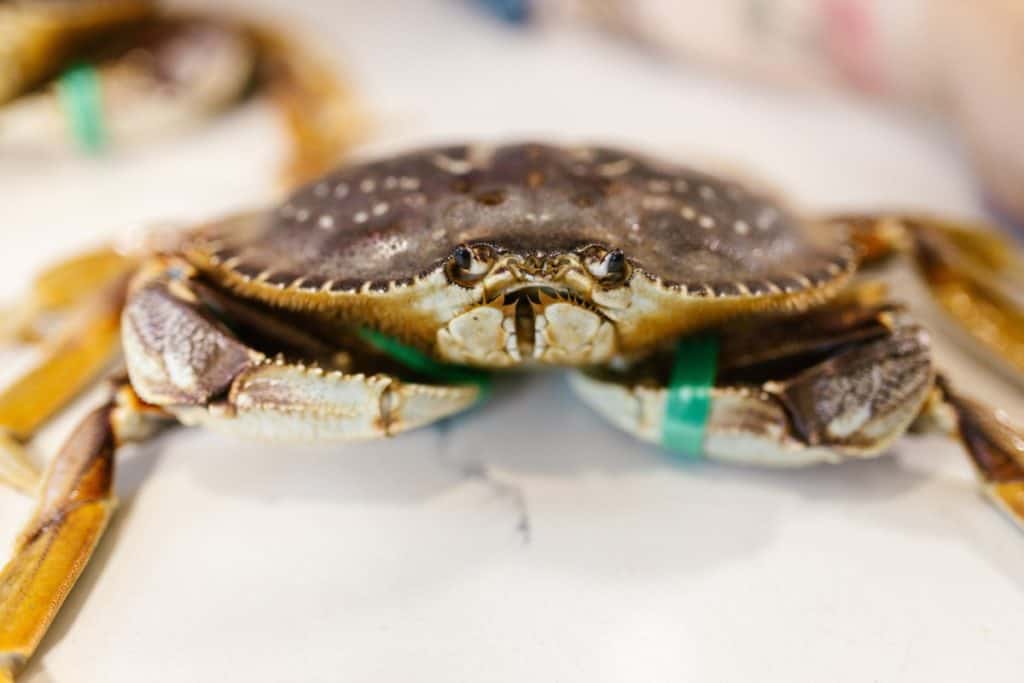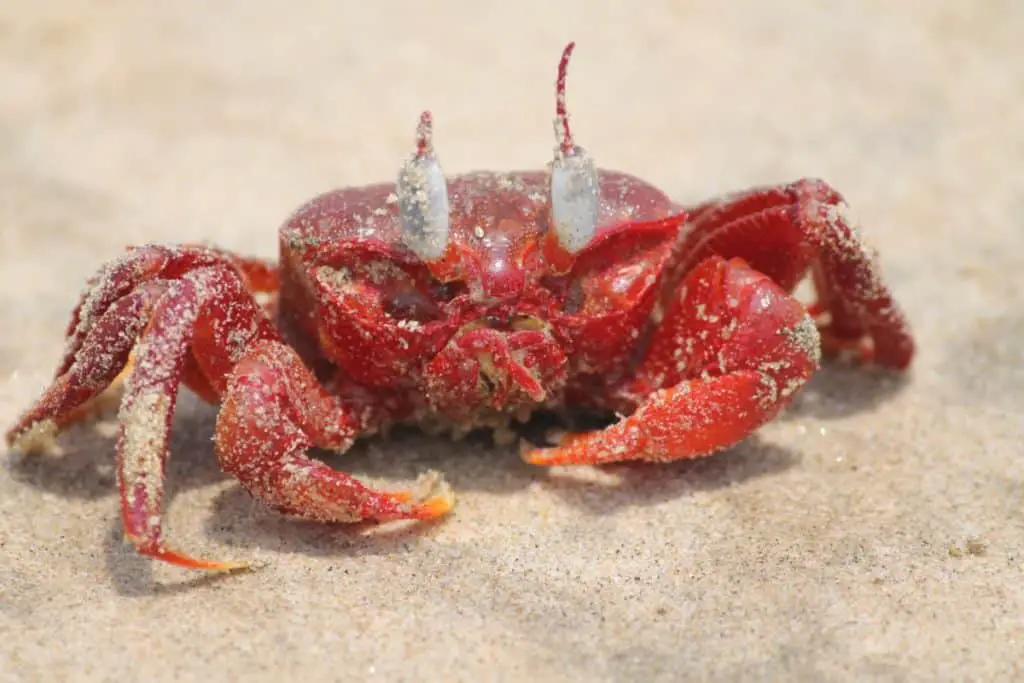
If you want to find out whether crabs have blood or not then you’ve come to the right article.
As, in this article, I’ll share the answer to this question with you, and also after you’ve read the answer to the main question then I’ll cover the answers to a few more closely related questions as well to extend your knowledge even more.
I hope that this article provides you with new knowledge!
Do Crabs Have Blood?
Crabs do have blood circulating in their bodies.
However, a crab’s blood is very different from the blood of humans.
It’s bright blue rather than bright red because the oxygen in the blood gets distributed throughout the crab’s bloodstream via copper (hemocyanin), and not iron (hemoglobin), as is the case for humans.
The blood of crabs is also more viscous with a jelly-like consistency that is different from mammalian blood.
Hemocyanin makes a crab’s blood less efficient than a human’s at transporting oxygen but much more resistant to cold temperatures and freezing.
Do Hermit Crabs Have Blood?
Hermit crabs have blood in their bodies.
It is normally a vivid or pale blue color but will sometimes appear more purplish depending on its oxygen content.
It might surprise you to learn that, while hermit crabs and other crustaceans do have a circulatory system, they do not have a centralized heart.
Instead, a crab’s blood gets pumped into and back out of specially designed cavities called Ostia.
The biological principles are similar to mammalian circulation but there’s no closed-loop system.
Do King Crabs Have Blood?
Like most crustaceans, king crabs do indeed have blood but it’s quite different from mammalian blood.
It’s a different color: a vivid blue instead of bright red due to the amount of copper it contains.
The blood of a king crab gets circulated via hemocyanin (rather than hemoglobin) which gives it a blue pigment.
The texture and consistency of a king crab’s blood are also different.
It’s much closer to jelly than liquid and becomes viscous and gel-like after clotting.
Do Dungeness Crabs Have Blood?
Dungeness crabs have blood inside their bodies just like most crustaceans.
It can be difficult to see because of the similar color of the water, the blood’s gel-like consistency after clotting, and the fact crustaceans will typically sever and abandon bleeding limbs to accelerate healing.
It’s sometimes possible to see small amounts of bluish liquid in crab buckets after fishing but only while the crustaceans are still alive.
Once dead, the amount of copper in the circulatory system decreases and the blood pales in color.
Do Crabs Have Blood Vessels?
Crabs, like most crustaceans, have a circulatory system but it functions very differently from a mammalian system.
The blood in a crab’s circulatory system is blue rather than red and contains copper for transporting oxygen (as opposed to iron).
This process of hemocyanin (rather than hemoglobin) is what gives the blood its purplish-blue pigment.
Crabs have no blood vessels.
Without a centralized heart, there’s no need for a closed loop system.
So, there is not a ‘circulatory’ system in the truest sense.
Instead of getting pumped through blood vessels, a crab’s blood is pushed through small cavities called Ostia and then pushed back out again and directed around the tissues.
This is what’s known as an open circulatory system and it’s typical for crabs and other crustaceans.

Do Crabs Have Blood In Their Legs?
Crabs have blood inside their legs though it’s not easy to see.
These remarkable sea creatures can self-amputate and regenerate wounded limbs.
Many different species can do this with varying degrees of success.
The hermit crab, for example, is particularly skilled at abandoning and regrowing its legs, and, for this reason, it’s notoriously difficult to spot their blood even when wounded.
If a hermit crab is attacked or becomes injured, it will readily sacrifice its wounded limb to survive.
Afterward, blood rushes to the site of the wound and becomes clotted and gel-like making it much harder to see.
Sometimes, small amounts of blue liquid can be seen in crab buckets, this is the crab’s blood.
How Much Blood Is In a Crab?
It was once thought that crabs had small amounts of blood in their bodies, making up around 10% of their total body weight.
But recent research suggests there’s a greater volume of blood in their circulatory systems than previously suspected.
Contemporary studies say it’s closer to 25% of a crab’s total weight.
Also, the horseshoe crab can survive after losing almost a third of its blood supply.
However, any degree of uncontrolled bleeding is dangerous for a crustacean and carries a mortality rate of between 3% and 30% (depending on various conditions).
Do Crabs Have Blue Blood?
Most crabs have blue-colored blood as opposed to the vivid red blood that mammals circulate.
The blood is blue because a different process moves it to the organs and tissues.
Instead of hemoglobin (iron) transporting the oxygen in the blood, it gets carried by copper (hemocyanin) which gives it a vivid blue or pale blue color.
Hemocyanin ensures that a crab’s body doesn’t freeze in frigid underwater temperatures.
This also means that there’s a much lower volume of oxygen in their blood, and thus, no highly oxygenated red color like we’re used to seeing in other animals.
Do All Crabs Have Blue Blood?
All crabs and most crustaceans have blue-colored blood but it can appear more purplish at times.
The blood gets less vivid as its oxygen content decreases.
So, if you have seen crab blood, it was probably a pale blue shade.
The blood inside a crab’s circulatory system is a deeper blue color, sometimes so vivid that it looks more like purple.
What Blood Color Do Horseshoe Crabs Have?
Horseshoe crabs have blue-colored blood that looks very different from the vivid red blood that’s inside human circulatory systems.
Depending on oxygen content, the blood may sometimes appear more purple than blue.
It gets paler and more viscous (like a gel) as it leaves the body and/or begins clotting.
Why Do Horseshoe Crabs Have Blue Blood?
The blue color of a horseshoe crab’s blood occurs because of a respiratory pigment called hemocyanin.
This is the crustacean equivalent of the hemoglobin found in mammalian circulatory systems.
It performs a similar function but uses copper (hemocyanin) to transport oxygen in the blood instead of using iron (hemoglobin).
This small difference has a noticeable impact on the color of the blood turning it a vivid blue, pale blue, or deep purple depending on the present oxygen content.

How Much Blood Do Horseshoe Crabs Have?
Among the many different crab species, the horseshoe crab might have the most interesting story to tell.
Its blue-colored blood contains an extraordinary type of prehistoric cell called an amebocyte.
These amebocytes produce a substance known as Limulus Amebocyte Lysate or LAL, a special compound that clots to safeguard the crab against bacterial toxins.
Marine biologists study horseshoe crab blood for an important reason.
They know how much blood a single crab’s body contains because the species is prized for its LAL compound.
Its blood makes up around 25% of its body weight and biologists extract small amounts to avoid killing the animal.
Anywhere between 50 and 400ml gets extracted per crab (depending on the size of the specimen).
The LAL is harvested from the blood and used for sterilization purposes in the surgical and pharmaceutical fields.
Just a small amount of LAL can determine if a surface or instrument is sufficiently sterile.
If bacteria are present, the LAL clots.
This is the reason why horseshoe crabs are caught in large numbers as their blood is extremely useful.
Also, horseshoe crabs can survive after losing almost a third of their blood supply.
However, any uncontrolled bleeding is dangerous and carries a mortality rate of between 3% and 30% (depending on conditions and the size of the specimen).
What Color Is the Blood of Crabs?
Crabs have blue-colored blood due to the high copper contents present in their circulatory system.
As oxygen increases, it may appear so vividly blue that it looks more like purple.
As oxygen decreases, the color pales until it’s light blue.
Can Crabs Bleed?
Crabs are capable of losing blood.
However, just like humans, they have biological mechanisms to safeguard against uncontrolled bleeding.
For instance, it’s very common for crabs to sacrifice a wounded limb by dropping it on the ground and abandoning it.
Often, it’s much less dangerous for the animal to clot their wound and regrow the limb later than to continue losing blood.
Depending on the size of the crab, a single crab can lose as much as a third of its blood supply and survive.
What Does Crab Blood Look Like?
Crab blood looks very different from our mammalian blood.
It is light or dark blue and has a gel-like consistency that gets viscous and sticky after clotting.
The greater the oxygen content, the darker and more vividly blue blood appears.
Check out the video below if you want to see what the blood of horseshoe crabs looks like and also if you want to find out why horseshoe crab blood is so expensive.
